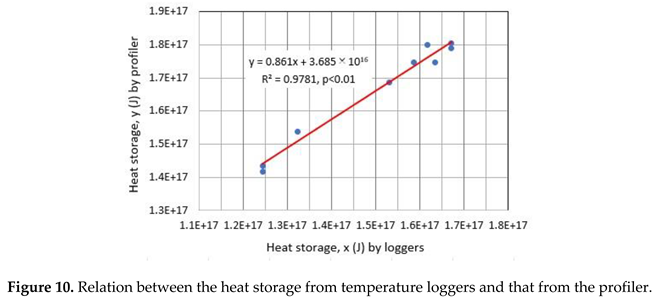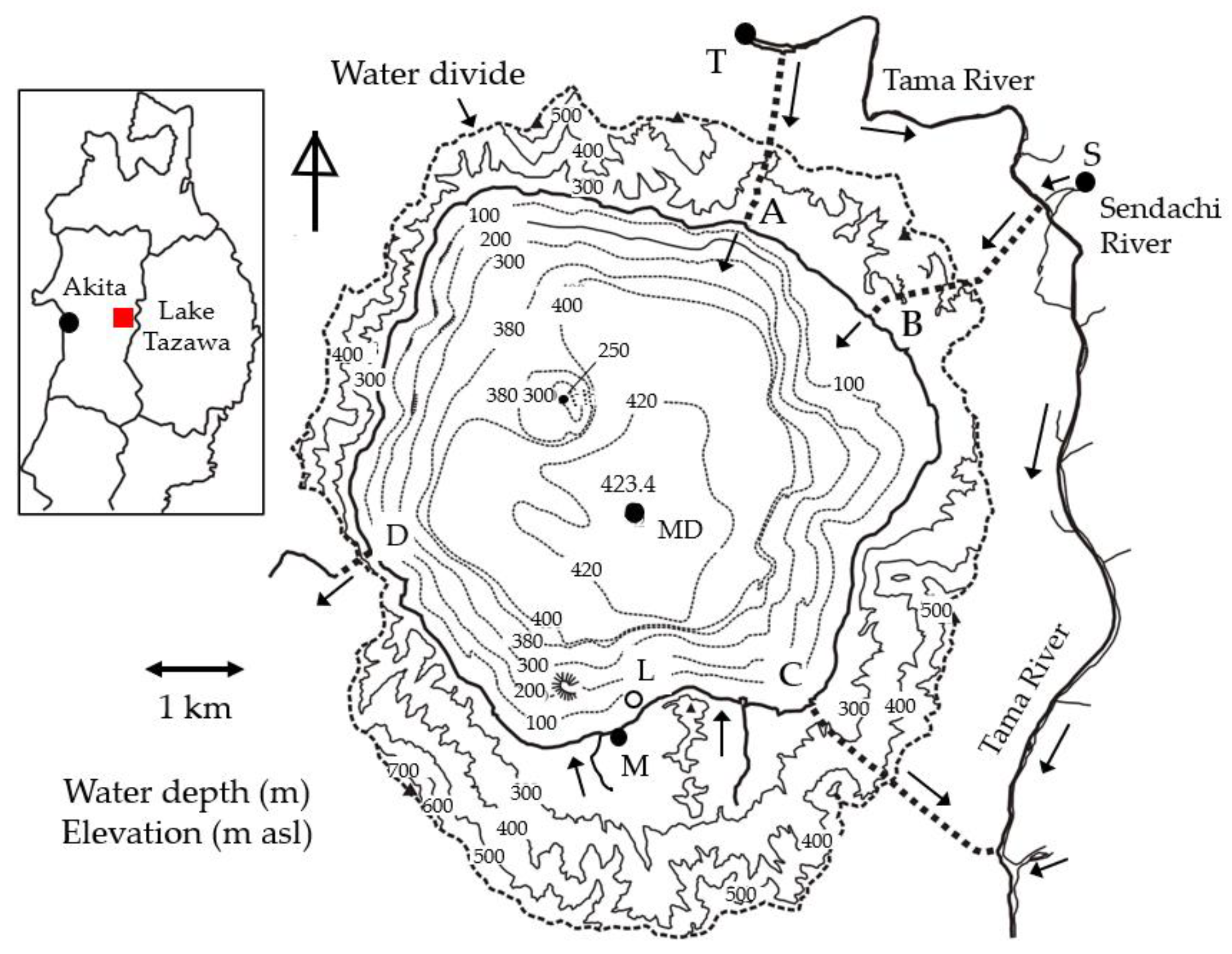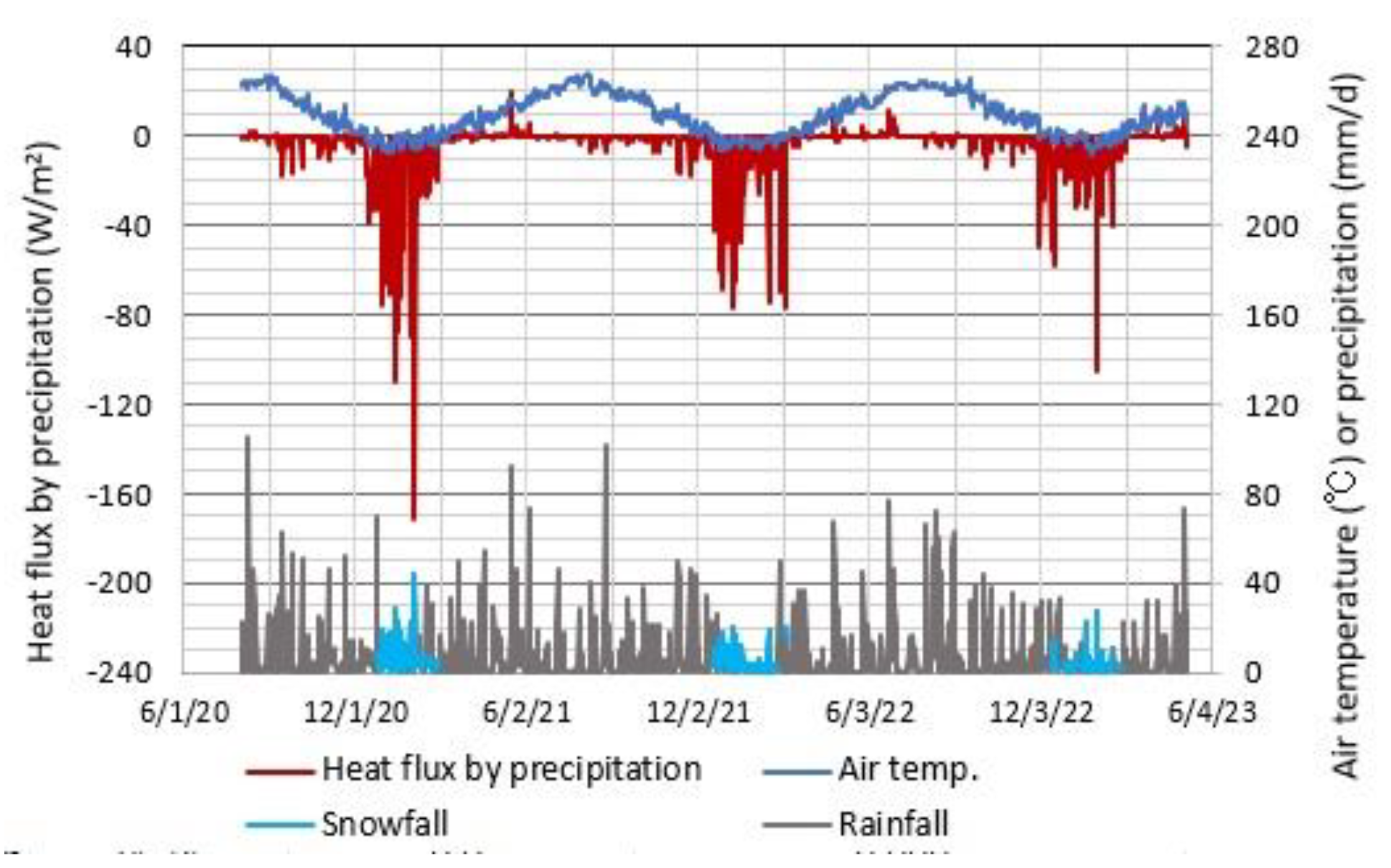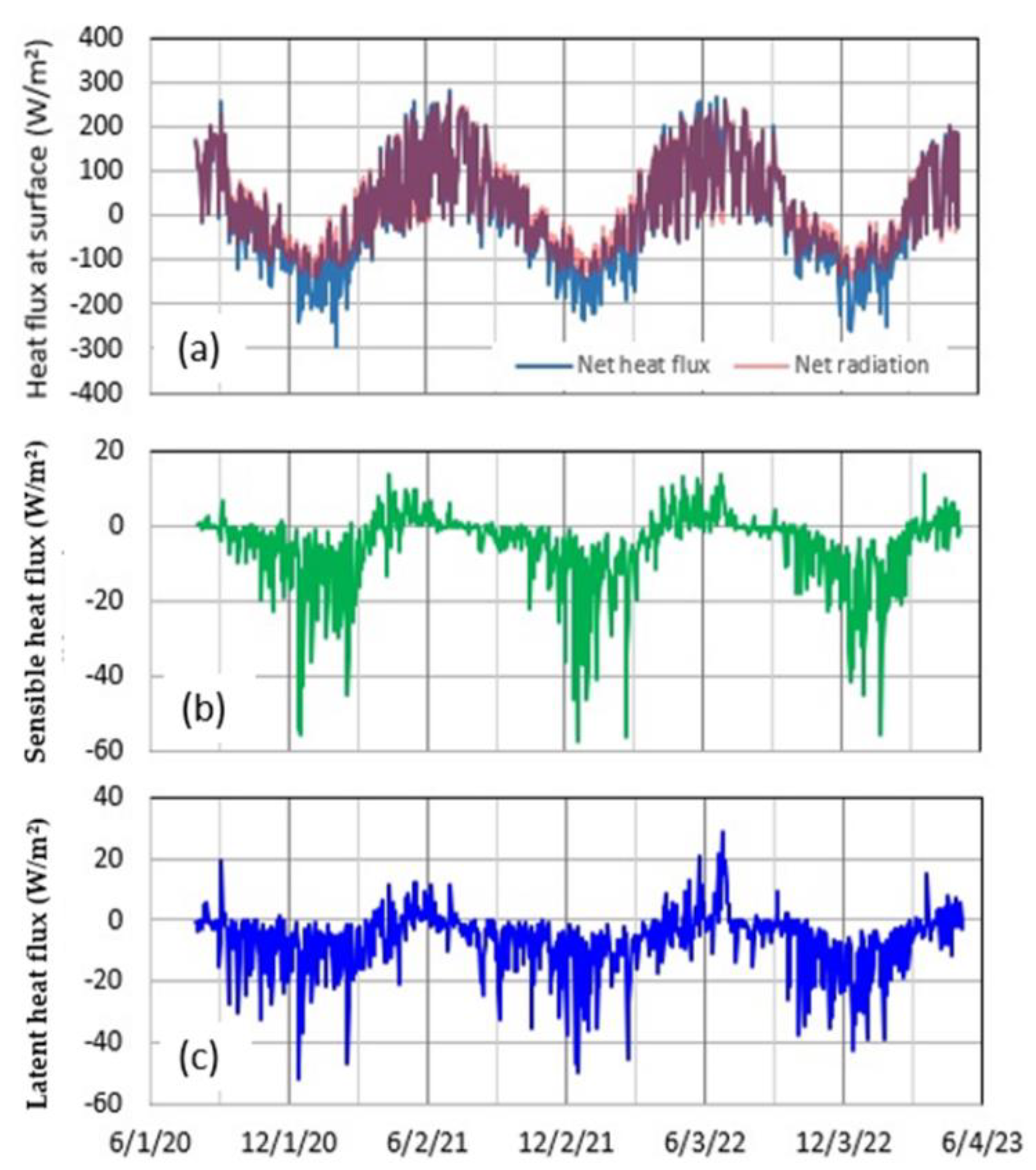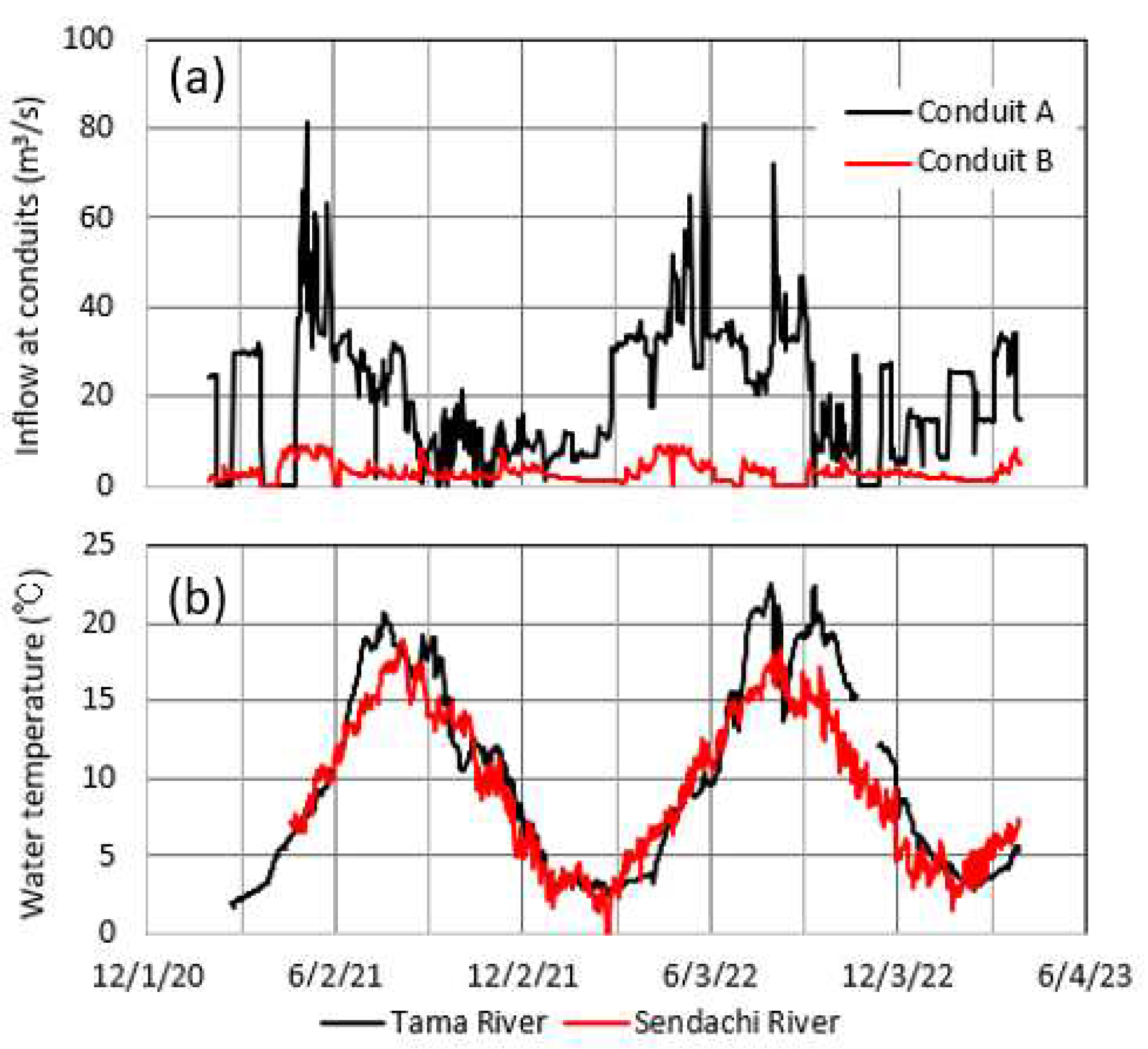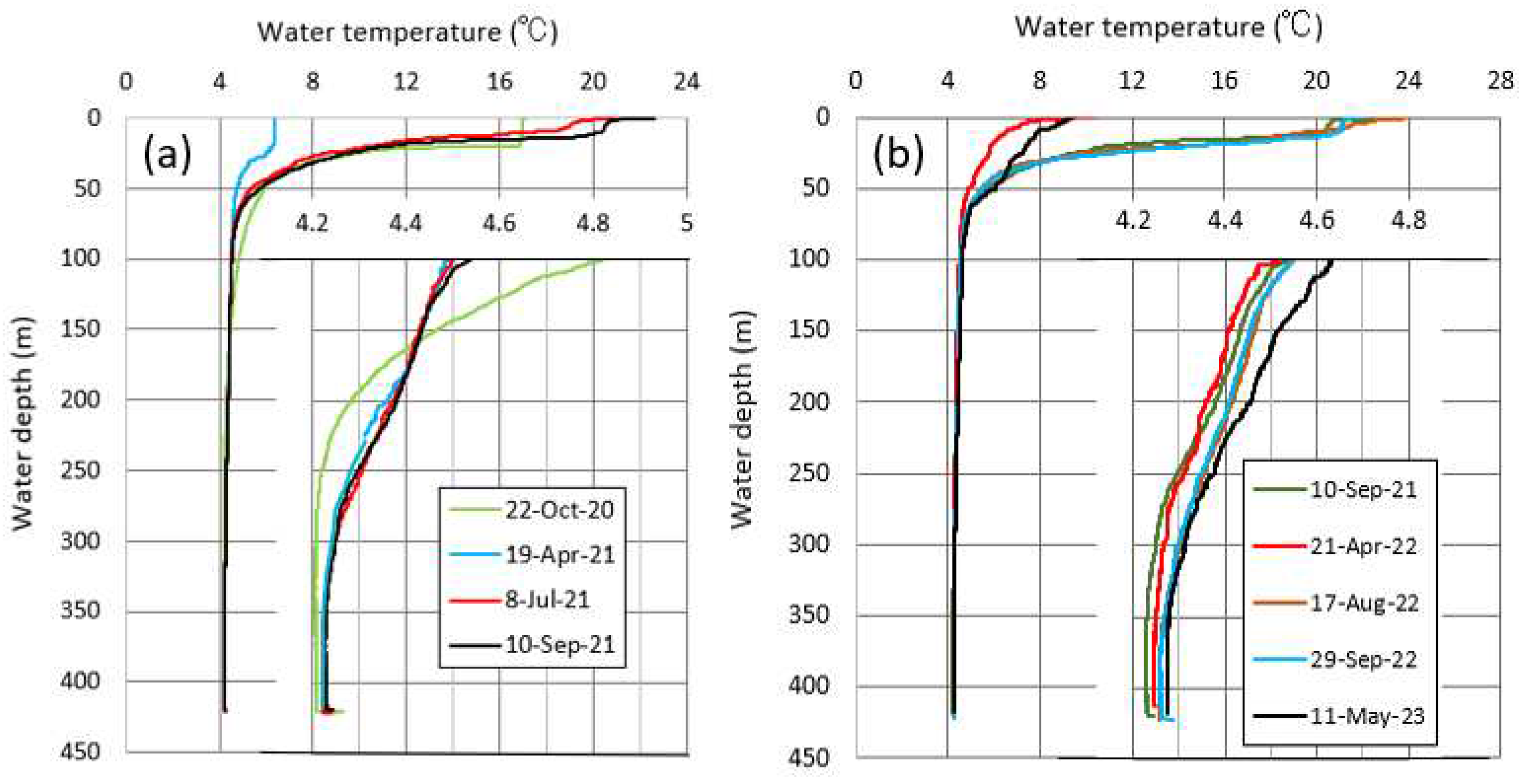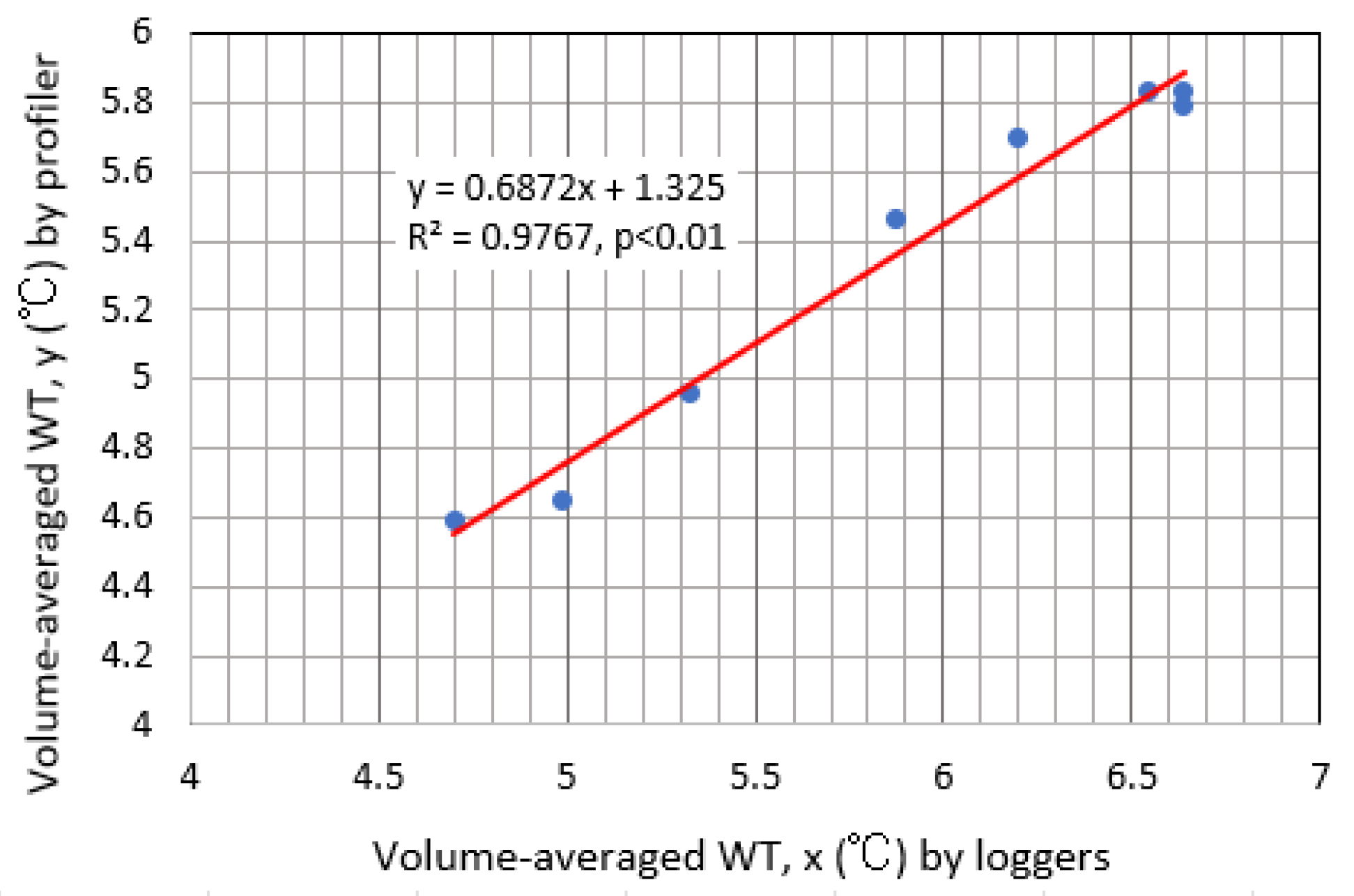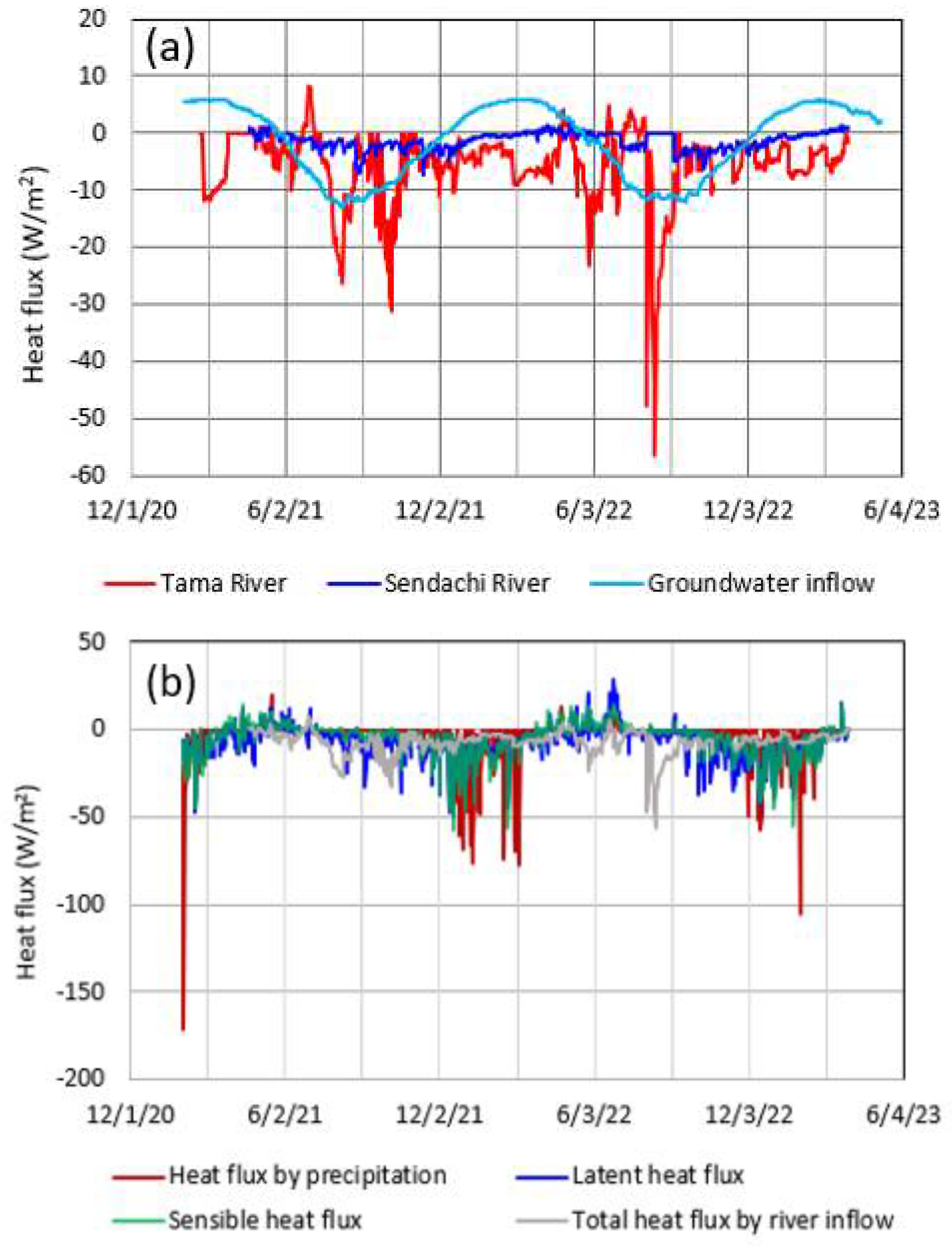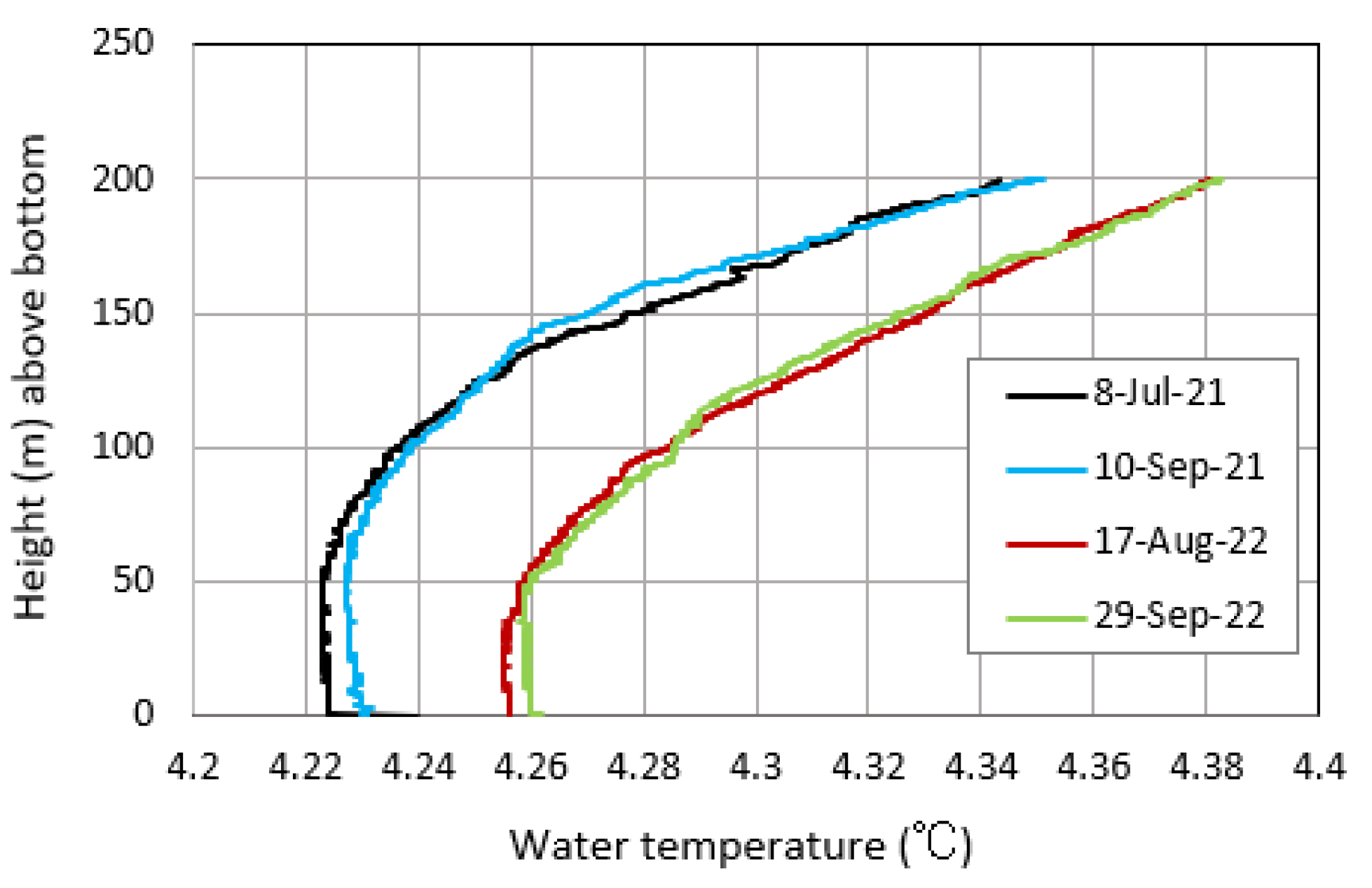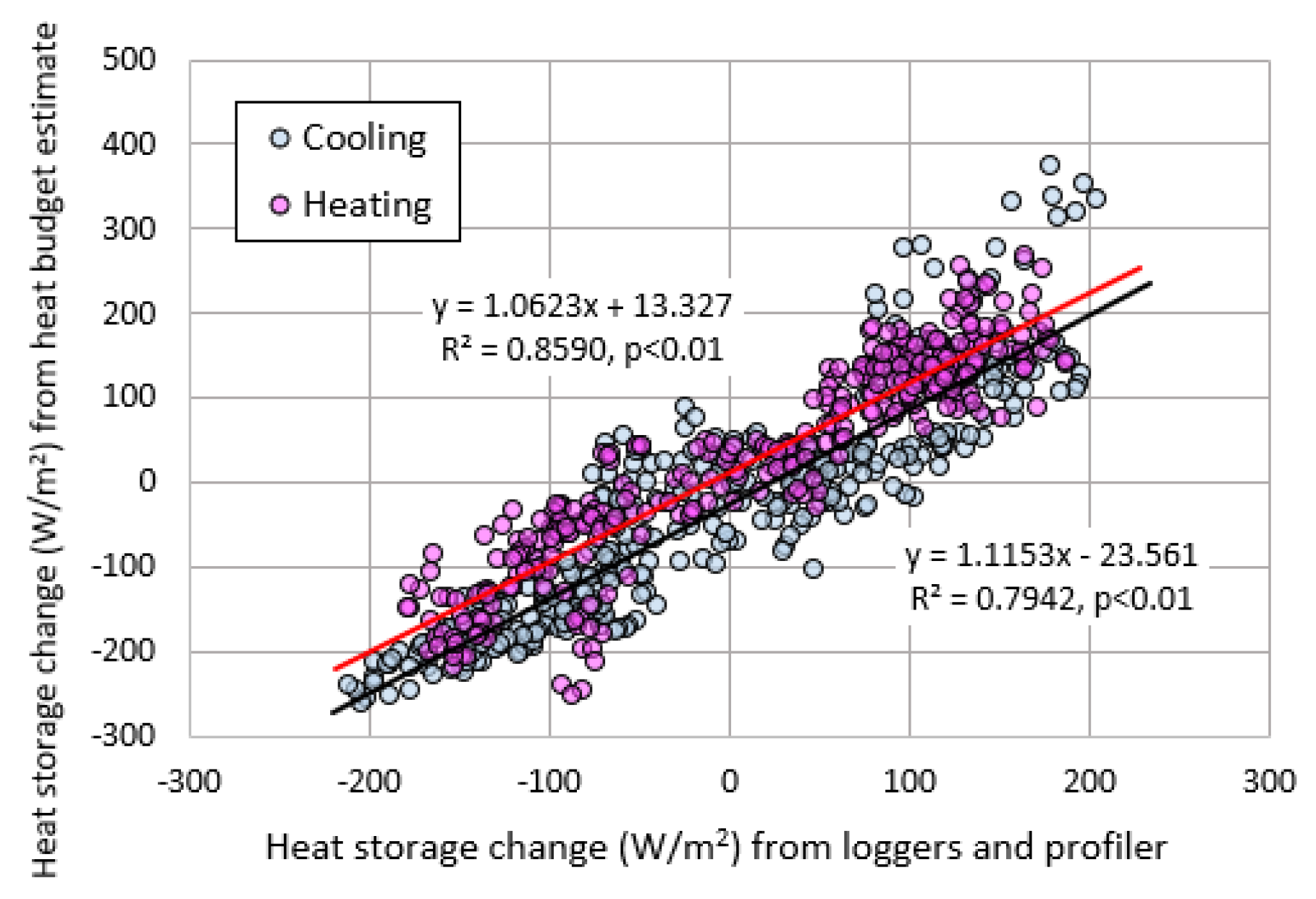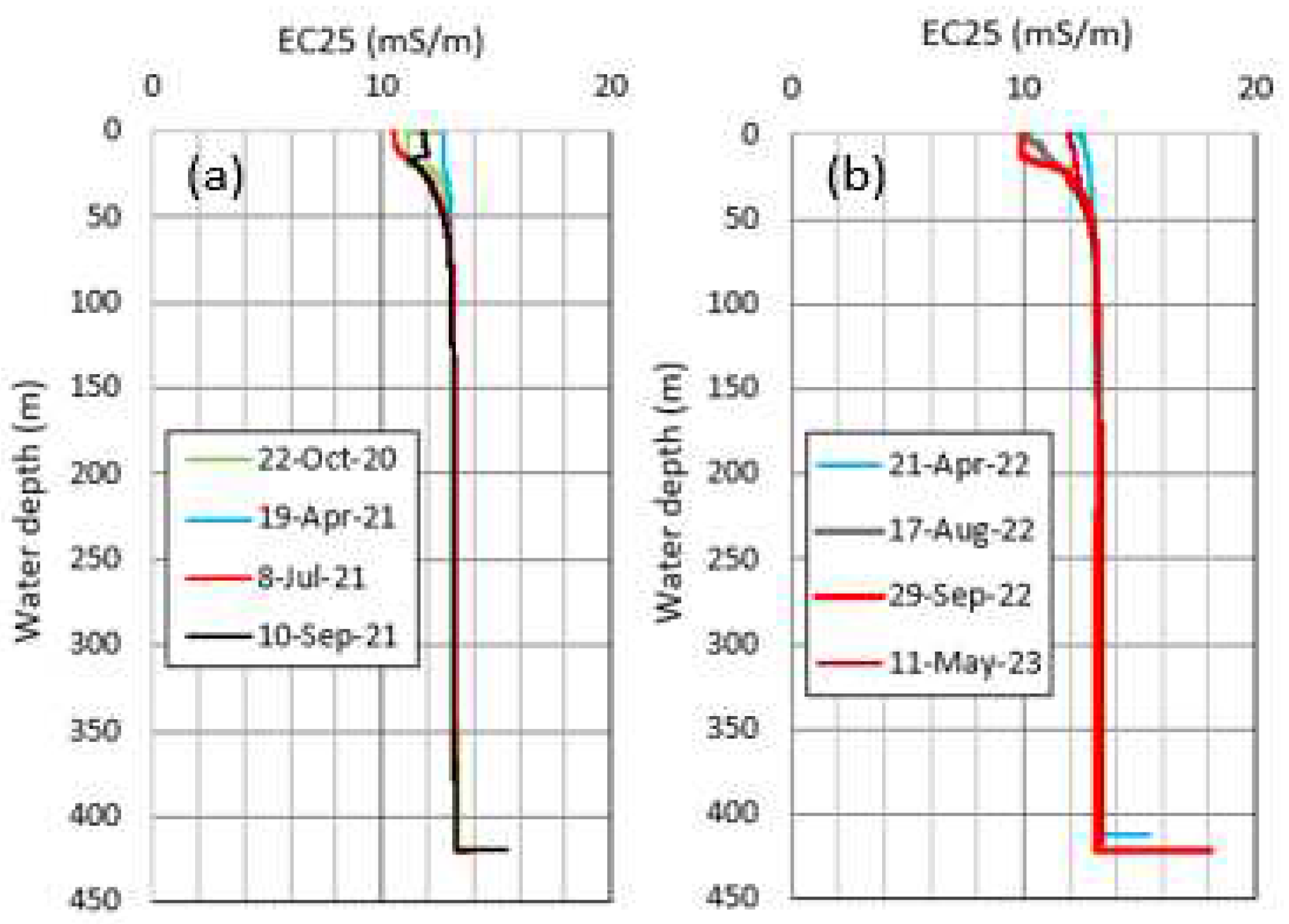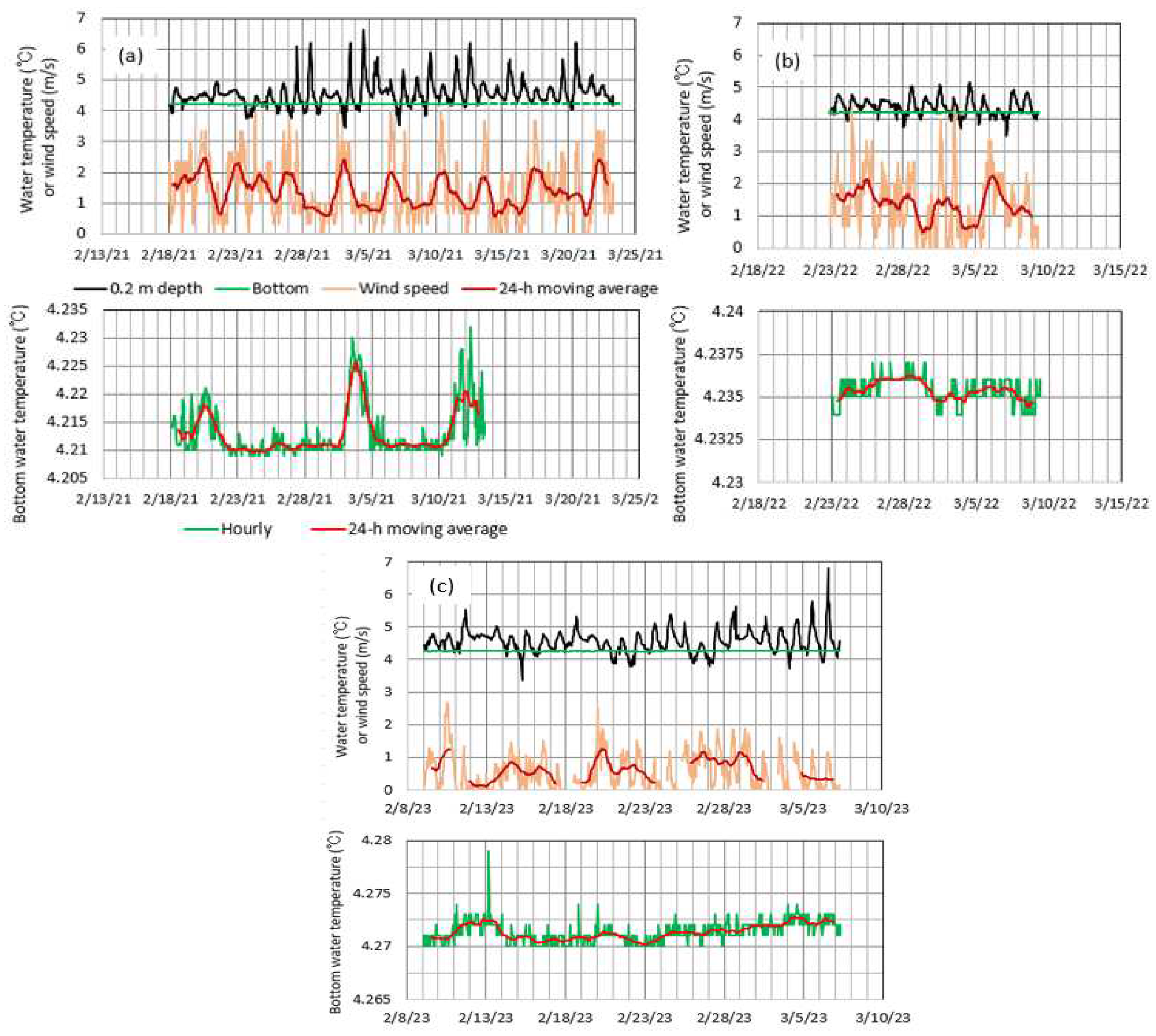3.1. Heat Budget of an Open Lake
The heat budget equation for an open lake (with an outflow river or an outlet) such as Lake Tazawa is given as follows:
where
ΔG/Δt is the total heat storage change (W or J/s) of the lake,
is the net radiative heat flux (W/m
2) at lake surface,
and
is the sensible and latent heat fluxes (W/m
2) at the surface, respectively (negative for heat output),
is the heat flux by precipitation over the lake,
is the heat flux by river, H
G is the heat flux by groundwater, H
S is the geothermal heat flux at the lake bottom, and A
0 is the lake water surface (m
2).
The net radiative heat flux
is composed of downward shortwave radiation K
, downward longwave radiation L
and upward longwave radiation
in the following:
where
is the albedo of shortwave radiation for water surface (here, assumed to be constant at 0.05). The upward longwave radiation L
is calculated by following the Stefan-Bolzman law for surface water temperature (K), where the emissivity ε of water is constant at 0.97. The downward longwave radiation
was evaluated by considering total effective water vapor content in the Stefan-Bolzman law for air temperature T
a [
11].
Sensible heat flux Q
H and latent heat flux Q
E were acquired by the following bulk transfer method:
where
is the isobaric specific heat of air (J/kg/K),
is the air density (kg/m
3), λ is the latent heat of evaporation (J/kg), u is the wind speed (m/s), T
s and T
a are the surface water temperature and air temperature, respectively (°C), q
s is the saturated specific humidity at surface water temperature, q
a is the specific humidity of air, and C
H and C
E are dimensionless bulk transfer coefficients for sensible and latent heat fluxes, respectively (here, C
H=C
E=0.0014 for the meteorology at 2 m above lake surface).
The heat flux Q
P by rainfall over the lake is given in the following:
where ρ
w is the water density (kg/m
3) at T
w, P
r is the rainfall (m/s), c
pw is the specific heat of water (J/kg/K) and T
w is the wet bulb temperature (°C). The T
w values were obtained by the dichotomy for the following psychrometer formula [
11]:
where p is the air pressure (hPa) (p
0=1013.2 hPa), e
a and e
w are the water vapor pressure (hPa) at T
a and the saturated water vapor pressure (hPa) at T
w, respectively, and B is the psychrometer constant (here, 0.667 hPa/K for the Assman ventilation psychrometer).
The heat flux by snowfall is as follows:
where ρ
i is the ice density (kg/m
3) at T
a, P
i is the snowfall (m/s) as ice at T
a, c
pi is the specific heat of ice (J/kg/K), T
melt is the melting temperature of ice (here, 273 K or 0 °C) and L is the latent heat of fusion (333.6 kJ/kg for ice at 0 °C). The precipitation during snowfall is generally evaluated by melting the snow over a tipping bucket raingauge. Hence, the snowfall at T
a was obtained by multiplying the precipitation at 0 °C during snowfall by the ratio of water density (999.868 kg/m
3 at 0 °C) to ice density at T
a. Here, the snow temperature was assumed to be equal to the air temperature T
a. The precipitation at T
a ≤0.5°C was supposed as snowfall [
11] on the assumption that, at 0.5 ≥ T
a > 0 °C, the snow temperature is 0 °C. Then, the first term of the right side in equation (7) is zero.
The heat flux H
R by river inflow and outflow and the heat flux H
G by groundwater inflow and outflow are given as follows:
where R
in and R
out are the river inflow and outflow (m
3/s), respectively, T
Rin and T
Rout are the water temperature of inflowing and outflowing rivers, respectively, T
o is the water temperature averaged in the surface layer of the lake, T
L is the representative lake water temperature, G
in and G
out are the groundwater inflow and outflow (m
3/s), respectively, T
Gin and T
Gout are the temperature of inflowing groundwater and that of outflowing groundwater, respectively, and A
o is the lake surface area (m
2). Here, the volume-averaged water temperature at depths of 0.2 – 10 m, considering each area from the bathymetric map (
Figure 1), was calculated as T
0. Then, the water temperature at 0.2 m depth was assumed to be equal to that at lake surface. In equation (8), for the heat flux by river inflow, the inflowing water was assumed to intrude only into the surface layer at depths of 0 – 10 m as density overflow [
12].
For the representative temperature T
L, similarly, the volume averaged water temperature of the whole lake was given by the following equation:
where H is the water depth at the deepest point, T
z and A
z are the water temperature and the area at a depth, z, respectively, and V is the lake volume. Here, H and V also vary temporally according to the temporal change of lake level. Equation (10) is based on the assumption that the water temperature at a certain depth is horizontally equal, i.e., exhibiting the thermal structure of a horizontal multi-layer in the lake. The supposition of T
L for the groundwater outflow is due to the point that it is unknown at which depth the groundwater outflow prevails. With respect to the heat flux by groundwater inflow, the volume-averaged water temperature T
0 between 0.2 m and 10 m in depth was chosen as the temperature on the lake side, assuming that the groundwater inflow into the lake occurs within 100 m offshore. According to spatial distributions of the confined aquifer exposed on lake bottom, Kabayashi [
13] indicated that, in Lake Biwa, the seepage flux into the lake occurs mainly within 200 m offshore. Hence, considering the bathymetry of Lake Tazawa (
Figure 1), the seepage flux into the lake was assumed to occur mainly at depths of 0 – 10 m within 100 m offshore. In equation (8) and (9), the second term of the right side was regarded to be almost zero, because T
Rout and T
Gout are likely to be equal to T
o and T
L, respectively.
The geothermal heat flux H
s was estimated by the temporal change of vertical water temperature profiles at the deepest point during the thermal stratification [
14].
Finally, the total heat storage change ΔG/Δt is numerically obtained by calculating each term of the right side in equation (1). Meanwhile, ΔG/Δt can be evaluated directly by monitoring water temperature at some depths between the lake surface and the bottom. Hence, it is possible to judge if the heat budget estimate is reasonable or not by a comparison with the heat storage change from the direct measurement.
3.2. Field Observations
In order to evaluate each term of the heat budget equation (1), the meteorology (solar radiation, air temperature T
a, relative humidity, rainfall, air pressure and wind velocity), and lake water temperature at 0.2 m depth were measured at 1 h intervals at site M on the lake shore and at site L for 1 August 2020 – 9 May 2023, respectively (
Figure 1). Temperature loggers, TidbiT v2 (Onset Computer, Incorp., USA; accuracy of ±0.2 °C) were used for the monitoring of the surface water temperature. Rainfall at site M was recorded in April to October, and rainfall or snowfall in November to March was supposed using the high correlation (r
2=0.869, p<0.001) with the rainfall data of a weather station at Senboku City, 6.5 km southeast of Lake Tazawa. At T
a ≤ 0.5 °C at site M, precipitation was assumed to be snowfall, and at T
a > 0.5 °C, to be rainfall. Here, the existence of sleet, i.e., the mixture of snow flakes and raindrops was neglected. The climatological effect on the lake was explored by using the 1977 – 2023 data from the weather station of Senboku City.
At site L, water temperature at 0.2 m depth were measured as lake surface temperature to calculate the sensible and latent heat fluxes Q
H and Q
E by the coupling with the meteorology, and the difference between air pressure at site M and water pressure at the bottom of site L allowed us to calculate the water depth to get the temporal variations of lake level. The lake surface area changed by the lake level was obtained by the bathymetry with 1 m depth contours (
Figure 1) [
2]. Inflow data at the conduits A and B, connected to the Tama River and the Sendachi River, respectively, were supplied by the Tohoku Electric Power Co., Ltd. (
Figure 1). The data supply was done every fiscal year of 1 April 2020 – 31 March 2023. Temperature loggers, recorded at 1 h intervals, were fixed on the riverbank at sites T and S at 0.66 km and 0.2 km upstream of the entrances of the conduits A and B, respectively.
Meanwhile, lake water temperature was recorded every 1 h at depths of 0.2 m, 5 m, 10 m, 20 m, 50 m, 70 m, 100 m and 200 m and at the bottom of site MD by setting a mooring system of temperature loggers (Figure 2). At 0.2 m depth and the lake bottom, temperature loggers with the high accuracy of ±0.01 °C and the resolution of 0.001 °C (model DEFI2-T, JFE-Advantech, Co., Ltd., Japan: URL
https://www.jfe-advantech.co.jp/products/ocean-defi2.html accessed on 12 October 2023) were fixed to judge the downward degree of vertical water circulation in water depth. At the other depths, the temperature loggers, TidbiT v2, were fixed.
Water temperature, electric conductivity at 25 °C (EC25) and dissolved oxygen (DO) were vertically measured at 0.1 m pitch by lowing a profiler on a boat (accuracies of ±0.01 °C, ±0.5 mS/m and ±0.4 mg/L, respectively; model ASTD, JFE-Advantech, Co., Ltd., Japan: URL
https://www.jfe-advantech.co.jp/products/ocean-rinko.html, accessed on 13 October 2023). The measurement by the ASTD profiler was spent about 40 min at a point. Using the bathymetric map of the lake (
Figure 1), the hourly heat storage G
hl (J) of the lake was calculated from the hourly temperature of the loggers. The G
hl values were calibrated by the correspondent heat storage G
p from the profiler, since there is a linear relationship between G
hl and G
p with a high correlation of r
2=0.978 (p<0.01). Using the calibrated G
hl, the heat storage change (W) of the lake was calculated as daily mean, which was compared with the ΔG/Δt values from the heat budget estimate by equation (1).
